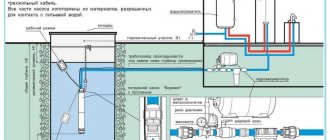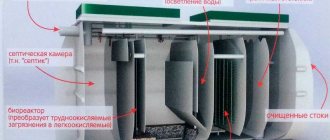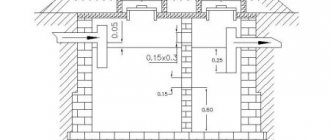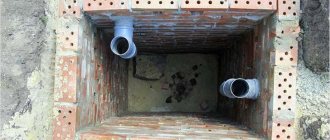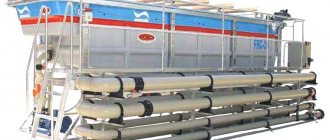Home improvement is a serious task, especially if the building cannot be connected to citywide utility networks. In this case, local systems are built, including a local sewerage system. But before construction begins, you will need to develop a project and carry out calculations. Let's figure out how to calculate the volume of a septic tank.
Local sewage systems are equipped with a treatment plant. Most often, such an installation is a septic tank with soil treatment. For the system to function normally, it is important that the tanks are large enough, otherwise the water will not be properly purified. Let's figure out how to calculate the volume of a septic tank.
How does it work?
To understand what volume a septic tank tank should have, it is worth getting acquainted with how this installation functions. Cleaning proceeds like this:
- the water entering through the pipeline enters the first settling tank, where primary settling occurs, during which the heaviest and largest particles settle;
- then the water, freed from the largest debris, flows through the overflow pipe into the second settling tank, where the settling process is repeated, only now lighter and smaller particles of debris are precipitated from the water;
- well-settled water is supplied for soil purification - into a filter well or to filtration sites.
As can be seen from the description, the main method of cleaning in conventional septic tanks is settling. And in order for the suspension to settle well, it must be at rest for a long time. In other words, the contaminated liquid must remain in the tanks of the treatment plant for a long time, only in this case it will have time to settle well.
It has been experimentally determined that to achieve an acceptable level of purification, the liquid must remain inside the settling tanks for at least 72 hours. Therefore, the tanks must accommodate the amount of waste generated at the serviced facility during this time.
Practical recommendations for calculating and choosing a septic tank
Having decided on the required displacement of the total active zone of a septic tank for a country house, you can begin the practical selection of the tank(s) for it. It must be a sealed vessel or several mounted in series.
Today, many types of containers are offered, from both factory and home-made production. However, the material of their manufacture does not directly affect the processes of biocenosis, while the form factor is of decisive importance.
Possible options for the functioning of septic tanks
Let's consider how to calculate a septic tank made of concrete rings and the no less popular ready-made factory-made “Tank” installation.
How to calculate the total volume of a prefabricated septic tank made of reinforced concrete rings
Reinforced concrete sewerage structures are distinguished by their reliability and practically unlimited service life. The problem that previously accompanied them - insufficient tightness - is now solved by modern means of waterproofing. Therefore, the use of ready-made reinforced concrete rings for wastewater treatment equipment is found in the vast majority of cases in the manufacture of anaerobic concrete tanks for small farms.
Scheme for calculating a septic tank made of concrete rings
We start calculating the volume of a septic tank from concrete rings with the already described theoretical calculations for determining its active volume (formulas 1 and 2), as well as the active volume with reserves (formulas 3 and 4).
We select rings based on the MDS 40-2.200 manual, which recommends placing the bottoms of the tanks at least 3 m from the ground surface. This is due to the technical capabilities of pumping out sludge using sewerage machines. Therefore, with a ring height of 890 mm, there can be no more than three of them in one well.
With a maximum ring height of 890 mm, there should be no more than 3 of them in the septic tank
In order to bring all the data together when calculating a septic tank made of concrete rings, you can rely on tabular indicators (Table 3), and also use the formula for the volume of a cylinder.
Vcyl=πr2*h or Vcyl=πd2*h/4, (5)
Where r and d are the internal diameters of the ring, respectively;
h is the height of the ring.
Let’s assume that the active volume of the working chambers, taking into account the sediment Voc (formula 3), is 3 m3. We use a two-chamber scheme, which in practice is convenient to implement from standard rings of equal diameters. For self-assembly, it is easier to order reinforced concrete products with internal dimensions of Ø 1000 mm, since they can, with appropriate skill, be installed manually. Let’s take just this option as an example.
Next, Table 3 will help you calculate the volume of a septic tank made of concrete rings. From it we find, using formula 5, that the internal volume of one ring with a height of 890 mm is equal to 0.785 m3. Not to be confused with the tabular volume, it shows the amount of concrete in the walls of the product. Therefore, to ensure the displacement Voc, we need K (pcs.) rings:
K=3/0.785=3.8≈4, (6),
that is, 2 pcs. for the first camera and 2 pcs. to the second.
We take into account that the height of the air volume above the liquid level (dry volume) cannot be less than 500 mm (clause 3.35, MDS 40-2.200). Therefore, we will need to add another ring with a height of 590 mm above each of the chambers.
Table 3. Dimensions of concrete rings
At this point, the calculation of the volume of a septic tank made of concrete rings can be considered completed, however, to bring the structure to its logical integrity, it is still necessary to select slabs for the bottom floors of wells and covers with mandatory inspection hatches.
Construction of a septic tank from reinforced concrete rings based on the results of the calculation
Calculation of the “Tank” septic tank for a country house
Purchasing a ready-made, factory-produced structure greatly simplifies the production of an autonomous sewage system. One of these popular designs in the Russian Federation is the Tank anaerobic station. If you decide to choose similar products, then calculating a septic tank for your home will also be simplified. Many official sellers provide a range of models from which you can order a treatment plant that can process any amount of wastewater from your household. For example, the “Tank 1” model has a maximum productivity of up to 0.6 m3/day, which is sufficient to serve from 1 to 3 residents.
Therefore, in the calculations of a factory septic tank for a private house, the main points will be:
- determination of wastewater volumes using formulas 1 and 2 without taking into account the coefficient D, that is, only for one day;
- selection of the area where installation will be carried out. The equipment turns out to be quite cumbersome, especially models for large volumes of wastewater, consisting of several separate modules.
What factors need to be taken into account?
As it becomes clear from the above, the volume of the tanks directly depends on how much water the residents use. Consumption is affected by:
- the number of users, that is, how many people live permanently and also come periodically. Naturally, in a facility for a family of 3-4 people, the amount of sewage will be significantly lower than in a residential building of a holiday home designed for 20 guests and 15 staff;
- equipping the house with plumbing. It is clear that in a house equipped with a 350-liter jacuzzi, the volume of wastewater will be greater than in a house that only has a shower, even if the same number of people live in these houses.
Septic tank models for 15 people
Septic tank BioDeka-15 C-800
| More details | Users: up to 15 people Salvo discharge: 750 l. Processing volume: 3 m3/day Price: 172,400 rub. |
Septic tank TOPAS 15
| More details | Users: up to 15 people Salvo discharge: 830 l. Processing volume: 3 m3/day Price: 192 690 |
Septic tank TOPAS 15 Long
| More details | Users: up to 15 people Salvo discharge: 850 l. Processing volume: 3 m3/day Price: 220 590 |
Septic tank Astra 15
| More details | Users: up to 15 people Salvo discharge: 650 l. Processing volume: 3 m3/day Price: 199 000 |
As a rule, the nominal number of people is indicated by the number on the septic tank label. For example, if next to the name there is 10 or 15, then this is the number of people the installation is designed for
If you are working on the installation yourself, then you need to calculate the septic tank and approach this issue responsibly. If the volume is too small, the water will be poorly purified, and a larger septic tank than necessary will have a high cost, and its construction will require increased costs.
Choosing a place to install a septic tank
Septic tank installation diagram
Plastic tank for septic tank
The main rule when installing a purification structure is that the volume must be sufficient to store the wastewater generated over three days
Its operating principle is such that the water must settle for 72 hours, only then can it be effectively purified.
The second parameter for calculation is the number of residents. Everyone who lives in the house uses household appliances, a bathroom and a toilet, so the volume of a septic tank for 3 people and, for example, 10 people is different.
Formula
The easiest way is to calculate the volume of a septic tank using a simple formula:
V = 3 * n * Q * 1.2
In this formula, the symbols indicate:
- V – volume of settling tanks;
- n – number of people;
- Q is the daily volume of wastewater.
The numbers indicate:
- 3 – the duration of the cleaning cycle lasts three days;
- 1.2 is the correction factor necessary to increase the volume of tanks in case of a temporary increase in the volume of wastewater, for example, in the event of the arrival of guests.
Advice! If the family is distinguished by hospitality and they have several people visiting, it is worth increasing the volume of the septic tank using a correction factor of 1.5.
How to determine the volume of waste?
If determining the main variables included in the formula does not cause difficulties, then problems often arise with the answer to the question of how to determine the daily volume of wastewater. This indicator depends on the number and type of plumbing fixtures.
The standard daily consumption value is 15 or 20 deciliters. If the facility does not have a bathtub, but only a shower stall, then the average daily consumption can be taken as 15 deciliters. If you have a bath, this figure should be increased to 20 deciliters.
Advice! If the house is equipped with a standard set of plumbing, but all family members are accustomed to taking a bath every day, then the daily volume of wastewater per person will be 30 deciliters.
Welcome to Unipedia
- Articles
- Sewerage
- Optimal septic tank volume for a private home: calculation rules
The communications of a country house have a local system, which is significantly different in design from the centralized sewer system. Autonomous functioning occurs according to a certain cycle. A reservoir is involved in the wastewater treatment process; many household factors depend on its volume; a lack of m³ of septic tank used will lead to various undesirable consequences, including the need for strict control over the amount of liquid consumed. Purchasing a huge container without calculations is simply a waste of money.
You can make the correct calculation and avoid unnecessary expenses by understanding the system as a whole.
Installation of a factory septic tank
A septic tank is a special tank, made independently or purchased from a manufacturer, in which wastewater is accumulated, organic compounds are gradually processed, and the purified liquid is disposed of.
The working process of a septic tank begins from the moment contaminated water enters the reservoir into the first compartment, called the settling tank - phase 1. The liquid settles, the wastewater is divided into fractions, heavy and large elements settle to the bottom, the rest of the liquid goes to phase 2 of purification in the second compartment, after clarified water goes into compartment number 3.
Division into fractions occurs at all stages, bringing water to 96% of its original state. Despite the high level of purification, such water can be used for technical needs; if there is no great need for technical water, the liquid is disposed of in the ground, where it achieves complete purification with soil.
Processing is carried out in the following ways:
- aerobic;
- anaerobic;
- mechanical method.
Aerobic and anaerobic cleaning methods are bacterial; they are characterized by the ability to carry out the vital activity of microorganisms in the absence of air in the system. A duct-equipped system can employ aerobic bacteria. The best option, according to practitioners, is that the use of both types of cleaning products gives the maximum effect.
The mechanical method is used separately, as a post-treatment facility.
It is a mistaken belief that efficiency depends on volume. The result of processing depends on the number of stages the wastewater passes through.
How many chambers should there be in a septic tank to obtain the desired result?
It is necessary to independently determine exactly how the purified liquid will be disposed of, since there are state sanitary, hygienic and environmental standards that clearly stipulate the degree of purification of recycled water into the soil. Maximum purification must be achieved to avoid contamination of drinking water sources.
SNiP 2.04.03.85 contains information for each type of building; permanent and temporary residences differ greatly in terms of water consumption.
Single-chamber septic tanks have the lowest degree of purification and constantly add new wastewater. Disposal of such water into the ground threatens an environmental disaster on the site.
Two-chamber septic tanks, average degree of purification, up to 55%, which also does not make it possible to freely dispose of liquid into the soil. The light suspended matter contained in it can cause significant harm; additional fields and wells need to be built to further purify the water coming out of the septic tank.
Three and four chamber septic tanks have a purification rate of 70 to 96%. Pumping of wastewater from one section to another occurs through pipes; the upper, cleanest layers of water in the section move. The percentage depends on the auxiliary biological material used. After which you can carry out additional purification in a well with a special filter mound.
We calculate the required volume of the septic tank
Having decided exactly how wastewater will be treated in the local sewer system, the question arises of how to correctly calculate the volume so as not to overpay for extra cubic meters.
The formula is quite complicated, especially for those who do not have the information. If you doubt your own abilities, it is better to turn to professionals.
W = 1460Qt0.33 C1.1 N0.55 T0.0283√ N
where W – Required volume of the septic tank in m³;
t – the time that the sediment is in the section, measured in days;
C – Indicator of the concentration of organic compounds at the outlet in one liter;
N – Daily water norm per person;
T – Temperature of liquefied wastewater;
Q – Indicator of the daily rate of wastewater in m³.
There is a simpler approach to solving this issue. It takes into account completely different factors. The basis is the constant standards established by regulations, which amount to 200 liters of water per day per resident (permanent stay). To these you need to add the water consumption of all household appliances, multiply by the number of days in the cycle for complete wastewater treatment in the septic tank, for most models this figure does not exceed 3 days and divide by 1000 - the coefficient that converts liters to m³.
The formula looks like this: V= (200*4+250)*3/1000
Calculation of the volume of a factory model for four people
Taking into account some standards, namely 200 liters per person per day, in total we get 800 liters x 3 days, we get 2.4 m³ - the minimum for a family, but this volume will not be enough, since guests come and there are household appliances. In addition to situations that are difficult to calculate, there are environmental norms and rules according to which the residence time is 14 days. 800 liters x 14 days, it turns out 11.2 m³. Such a tank is very large in size, which makes installation impossible in small areas, but with a water consumption of 800 liters per day, you cannot get another volume.
The solution is to reduce the load on the sewer system. There will be no less feces, but you can reduce the amount of solid fats that are difficult to process by microorganisms. Dispose of any remaining plant products in a compost pit or other place, but do not flush them down the toilet.
The productivity of bacteria is reduced by the entry of chlorine-containing substances into the septic tank, which adversely affect the population and life cycle of the microflora.
By limiting the discharge of various types of waste into the sewer system, the volume can be reduced to 400 liters in 24 hours. 400 liters x 14 days = 6.72 m³, which is quite suitable for a family of 4 people. When purchasing a septic tank, it is better to round up the number and make a small reserve in case guests arrive.
Any figure obtained from the calculations will be divided by the number of compartments if the capacity is not a single-chamber model. A three-chamber septic tank divides the total volume in this way: the first compartment is 3.5 m³, compartments numbered 2 and 3 are 1.75 m³ each.
Taking into account all the nuances of operation, the recommendations of the owners, water consumption and the volume of the tank must be planned in such a way that the sewer can be removed in one or two full trips, without paying for an unfilled tank. The tank of a sewer truck, on average, is 3.8-5 m³.
Calculation of the volume of a septic tank from building materials
Very often they resort to creating a septic tank with their own hands, using reinforced concrete blanks. You can calculate the volume for such a structure in this way. First you need to know the types of rings and their diameter:
- meter ring – internal diameter 0.7 m³;
- 1.5 meter product – 1.57 m³;
- 2 meter – 2.8 m³.
The drain pipes for the movement of waste are located in the upper part, but are not as close as possible to the hatch; this arrangement allows the tank to be filled by 80%. To provide an internal volume of 6.72 m³ for four people, you need 6.72/0.8 = 8.4 m³ - the figure for the external volume.
Now you need to divide the resulting figure by compartments and elements.
A septic tank of two chambers of 4.2 m³ each consists of three one-and-a-half reinforced concrete rings of 4.71, then the volume of both sections will be 9.42 cubic meters. meters.
A septic tank of three chambers: compartment 1 - 3 pieces of 1.5 meter rings, compartments 2 and 3 - three meter pieces each - the volume of one section is 2.1 m³. We add up the indicators 4.71 + 2.1 + 2.1 = 8.91 m³, at 80% load - the volume of the working space is 7.1 m³.
You can assemble any required volume; remember the installation rules, without which operation will be difficult.
Optimal septic tank volume for a private home: calculation rules
Options for arranging septic tanks
Installation of a septic tank in a private house
Sectional septic tank wells
Septic tank layout
Examples of calculations
Let's give a couple of examples of how you can calculate the optimal size of settling tanks
Example one
Conditions: A local sewage system is being built at home for a family of five members. The house is equipped with a standard set of plumbing fixtures, the daily volume of wastewater per person is standard - 20 deciliters. We carry out the calculation using the above formula: V = 3 * 5 * 20 * 1.2 = 360 deciliters or 3.6 m³.
Example two
Conditions: you need to determine the optimal volume of a septic tank for a dacha where 3 people will relax in the summer, and 1-2 people will often come to visit. The dacha is equipped with a shower, so the daily volume of wastewater will be 15 deciliters: V = 3 * 3 * 15 * 1.5 = 202.5 deciliters or 2.02 m³.
Example three
It is necessary to calculate the volume of a treatment plant for a motel with a capacity of 20 guests. Since motels do not have bathtubs, the daily consumption can be taken as 15 deciliters. And since, in addition to guests, the motel has service personnel, it is worth using the maximum increasing factor: V = 3 * 20 * 15 * 1.5 = 1350 deciliters or 13.5 m³.
What to consider when choosing a septic tank
Today, many city dwellers choose to live in the countryside, but many are not prepared for the difficulties that arise, and this is, first of all, the lack of communal infrastructure. Issues of water supply and waste disposal have to be resolved using different methods, and in this case it is important to minimize the risk of sewage getting into the ground and water bodies. According to the provisions of SNiP 2.04.03-85, the degree of purification of liquid discharged into a reservoir must comply with the provisions of legislative acts regulating environmental protection issues. If water purified in a septic tank is reused, sanitary and hygienic standards will come into force.
The main advantage of local wastewater treatment systems is the possibility of maximum effective treatment for reusing water for technical purposes, including irrigation. When choosing a waste disposal unit, the following factors must be taken into account:
- the number of people living in the house;
- frequency of stay;
- soil characteristics and composition;
- terrain characteristics;
- deep water level;
- depth of soil freezing.
A local treatment facility is selected depending on the specific conditions and characteristics of the area. This can be a storage tank sufficient to cope with wastewater at a dacha intended for seasonal residence, settling tanks and full-fledged biological treatment stations. The latter guarantee almost one hundred percent wastewater treatment and significantly reduce the frequency of using special equipment. Therefore, when installing a septic tank, you also have to take into account the volume of the sewage truck, and the standard model can accommodate 3.75 “cubes” of sewage. It remains to find out how to calculate the volume of a septic tank, taking into account the main factors.
How many cameras should there be?
The number of chambers, as well as the total volume of the treatment plant, directly depends on the volume of wastewater to be disposed of. For private residential properties (houses, dachas), as a rule, two sealed settling tanks are built.
In addition, a third element is included in the system; this can be a filter well or filtration platforms. If a large septic tank is being built to serve 15 or 20 users, then the number of settling tanks should be increased.
When building a two- or three-chamber installation, the dimensions of the chambers are made unequal. So, the largest should be the receiving compartment. In the two-chamber version, it should occupy 75% of the total volume, since it is in this compartment of the septic tank that the heaviest and largest inclusions settle. If a three-chamber version of a septic tank is being built, then the receiver should account for 50% of the total capacity, and the remaining two chambers should be made identical.
Advice! Not in all cases, chambers are made different in volume. For example, when building a treatment plant from reinforced concrete well rings or Eurocubes, all compartments of the installation will be the same.
Required volume of septic tank for a bath
Today we hear more and more often about a healthy lifestyle, so even in the countryside you can find a Russian bathhouse or sauna. Their presence significantly increases water consumption. In order for the local sewage system to work efficiently, the volume of the septic tank for the bathhouse will have to be added to the calculated indicators. In this case, it is better to use two-chamber septic tanks or biological treatment stations rather than storage tanks. The minimum consumption in the bathhouse is 100 liters of water per day, so the productivity of the device must be increased by 300 l/day. For bathhouses, plastic septic tanks are most often chosen, although many prefer durable devices made of concrete rings.
What can errors in calculations lead to?
If the volume of the settling tanks is determined incorrectly, the installation will perform worse. So, if the capacity of the installation is insufficient, the liquid will not have time to settle properly and poorly purified water will be supplied to the outlet.
This will lead to the fact that the soil filter used for post-treatment will quickly become silted and will become worse at filtering water. Restoring the system will require labor-intensive repairs.
It is not practical to build sedimentation tanks with a large reserve volume for economic reasons, since the construction of a large-capacity septic tank will cost much more than the construction of a compact model.
So, in the process of designing a local sewerage system, a septic tank is calculated. It is very important to do this work correctly, since the quality of the treatment plant will depend on it. If you plan to buy a ready-made septic tank, then there is no need to carry out calculations; the manufacturer must indicate the performance parameters of the model in the documentation.
Calculation of installation of multi-chamber septic tanks
In order to increase the productivity of the septic tank, it is recommended to divide it into two chambers. If you use a septic tank when consuming 5 cubic meters of water per day, then it will be enough with one chamber. If more than 5 cubic meters of water are consumed, then it is advisable to install a three-chamber tank.
Storage tank
If the septic tank has two chambers, then the volume of the first chamber should be 75 percent of the total volume of the septic tank. The second septic tank should be 50% of the total volume.
Important ! For a three-chamber septic tank, the volume of the first tank should be about 50 percent. The second and third tanks each use 25 percent of the total volume.
To ensure that installation of the tank does not take much time and effort, you can deviate slightly from the specified values.
Advantages of using a septic tank selection calculator.
In addition to the septic tank selection calculator , you can also use the services of relevant organizations that will make all the necessary calculations, take into account the homeowner’s wishes and tell you which parameters he should rely on when choosing a system, as well as which models he should pay attention to. Specialists will ask for the same parameters as the calculator, after which, after a certain period of time, they will give the calculation results. Of course, not for free.
The septic tank selection calculator presented on the website of the Stroy Project organization will do the same. However, this will take much less time, and all calculations using this function are carried out free of charge. The calculator does not have to go to the site to evaluate everything with his own eyes. In this case, you can see tangible savings in time and money for the customer.
You can use the calculator at any time of the day or night, since the website of the Stroy Project organization is freely accessible around the clock. And, after the user has received the calculation results, he can familiarize himself with the proposed models, their characteristics, parameters and technical features. After studying all the proposed options, all that remains is to make your choice, or seek help from the company’s employees who will help him make the right choice.
When savings are not justified
When discussing the situation, how much volume of a septic tank is needed at a particular site, we never recommend reducing the functionality of the facility “close” to the actual drains. In the construction industry, saving resources must be approached with extreme caution. This is explained by the fact that even in domestic wastewater there are many inclusions that are difficult to process by anaerobic bacteria. And they cannot break down some substances at all. We mean, first of all, such complex compounds as fats.
Our task, as professionals, is to select the optimal volume of a septic tank for a private home so that the structure can effectively clarify wastewater. This process involves the settling of suspended particles to the bottom. They are subsequently processed or pumped out using a sewage disposal machine, and the purified water is discharged according to a scheme previously agreed upon with the client.
Important! Calculation of the volume of a septic tank for a private house should be focused on normal indicators in the direction of increase. In this case, you can count on the fact that the structure will effectively cope with the assigned tasks, and there will be no problems with its maintenance. Otherwise, silt deposits and fats, after being drained into the drainage well, will quickly clog the soil, and the water will stop going further for filtration, that is, the sewage treatment system will fail. In a word, you need to save “a little in reserve.”



